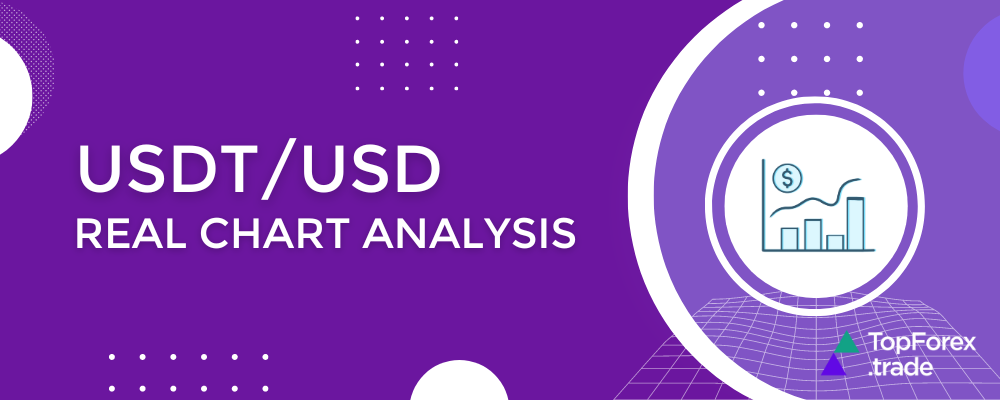Your guide to trading USDT/USD: indicators, strategies, and Top broker picks

The USDT/USD trading pair, representing Tether against the US Dollar, is one of the most stable yet intriguing assets for traders, offering unique opportunities for both beginners and experts. Understanding how to analyze this pair effectively is crucial for making informed trading decisions. In this article, we delve into the key technical indicators like the EMA, Bollinger Bands, and RSI, and explore chart techniques that can help you spot trends, gauge momentum, and assess volatility. We also provide expert trading strategies tailored for different risk appetites, ensuring you’re well-prepared to navigate this market. Additionally, we highlight the top FX brokers that provide the best platforms, tools, and conditions for trading USDT/USD.
A detailed explanation of the USDT/USD chart analysis

Let’s dive deeper into the analysis of each indicator and market condition to help you better understand how they function and what they might indicate for future price movements.
Disclaimer: This analysis is based on a real chart taken from the Investing.com website and is intended solely as a guide for beginners on how to analyze charts. It should not be considered as financial advice or a recommendation for trading.
Analysis of the USDT/USD chart
1. Exponential Moving Average (EMA)
- What is the EMA? The EMA is a type of moving average that reacts more quickly to recent price changes compared to a Simple Moving Average (SMA). Traders use it to identify the direction of the current trend and potential points where price action could change.
- Current reading: The 9-period EMA (blue line at 1.0003) is hovering close to the current price, showing that recent prices have been fairly stable with no strong upward or downward bias. The EMA slightly above the price might indicate a minor bearish trend, but the proximity suggests this trend isn’t very strong.
- Interpretation: When the price is below the EMA, it typically indicates a bearish or downward trend. When it’s above, it suggests a bullish trend. However, because the price is very close to the EMA, it indicates indecision in the market, with neither bulls (buyers) nor bears (sellers) showing significant dominance.
Pro tip: Check out how to use Moving Averages in CFD trading.
2. Bollinger Bands (BB)
- What are Bollinger Bands? Bollinger Bands help measure market volatility and identify overbought or oversold conditions. The middle band is usually a 20-day SMA, while the upper and lower bands are set 2 standard deviations away from the SMA. When the bands are far apart, it signals high volatility; when they are close together, it indicates low volatility.
- Indicator color: Blue bands around the price
- Current reading: The Bollinger Bands are relatively narrow, indicating a period of low volatility or consolidation. The price is also close to the middle band, which suggests that there is no clear trend direction.
- Interpretation: Narrow bands often precede periods of higher volatility. If the price moves outside the bands and stays there, it could indicate the start of a strong trend in that direction. For now, the price is within the bands, so a sideways movement is more likely.
3. Relative Strength Index (RSI)
- What is the RSI? The RSI is a momentum oscillator that ranges from 0 to 100. It helps identify overbought or oversold conditions. A value above 70 typically indicates overbought conditions, suggesting a potential price decline, while a value below 30 indicates oversold conditions, suggesting a potential price increase.
- Current reading: The RSI is at 45.5, which is within the neutral zone (30-70). This indicates a balance between buying and selling pressures and suggests that there isn’t a strong momentum in either direction.
- Interpretation: An RSI around 45 does not signal any overbought or oversold conditions, reinforcing the idea that the market is in a consolidation phase without any significant momentum. Traders might wait for the RSI to move closer to the extremes (30 or 70) to find better trading signals.
4. Volume
- What is Volume? Volume shows the number of shares, contracts, or units traded during a specific period. High volume indicates strong participation and interest in the market, while low volume shows weaker interest.
- Current reading: The volume bars are mixed with no significant spikes, indicating moderate participation in the market. There is no notable surge in buying or selling pressure.
- Interpretation: Moderate and stable volume suggests a lack of conviction among traders. A sudden increase in volume could signal a breakout or breakdown, indicating a stronger move in either direction.
Analysis of the USDT/USD trend, momentum, and volatility
- Trend analysis: The trend appears to be neutral or sideways, with the price closely aligned with the EMA and moving within the Bollinger Bands. There is no clear upward or downward trend, indicating indecision or consolidation in the market.
- Momentum analysis: The RSI near 45 shows that there isn’t strong momentum in either direction. Both buyers and sellers are balanced, and the market is not exhibiting strong signs of being overbought or oversold.
- Volatility analysis: The narrow Bollinger Bands indicate low volatility. This means the market is consolidating, and there is a higher probability that a significant price move could occur when volatility increases. Low volatility periods are often followed by high volatility periods, so traders should be prepared for a potential breakout.
USDT/USD predictions and trading plan
Price prediction:
Expect continued sideways movement in the short term. However, a breakout could occur in either direction if there is an increase in volatility, indicated by expanding Bollinger Bands and rising volume.
Trading plan:
- For conservative traders: Wait for a breakout beyond the Bollinger Bands (above the upper band or below the lower band) accompanied by a noticeable increase in volume. This could signal the start of a new trend. Enter the trade in the direction of the breakout.
- For aggressive traders: Consider trading within the range defined by the Bollinger Bands. Buy near the lower band and sell near the upper band. Monitor the RSI to ensure that it remains in a neutral range (30-70), and watch the volume for confirmation of any trend changes.
More about bulls and bears in the Forex market.
Key takeaways for beginners to trade USDT/USD
- EMA helps identify the trend direction. When the price is close to the EMA, the market is usually in a consolidation phase.
- Bollinger Bands measure volatility; narrow bands indicate consolidation while expanding bands suggest increased volatility.
- RSI is a momentum indicator that helps identify overbought or oversold conditions. A neutral RSI suggests no strong momentum.
- Volume confirms trends; low volume indicates consolidation, while high volume may signal the beginning of a new trend.
By understanding these indicators, you can better analyze price movements and create a more informed trading plan. Remember, this is not financial advice—always perform your research and manage your risk carefully.
Top Forex brokers to trade USDT/USD
After gaining a solid understanding of how to analyze the USDT/USD trading pair and mastering various strategies, the next step is to find a reliable broker that suits your trading needs. With so many options available, it can be challenging to choose the right one. We’ve compiled a list of Top FX brokers that offer competitive spreads, advanced trading tools, and secure platforms to help you trade USDT/USD with confidence.
Pro tip: Before choosing a Forex broker, check Forex brokers with the best reputation among real traders.
eToro Crypto trading
eToro, established in 2007, has revolutionized Cryptocurrency trading by making it accessible and engaging for traders worldwide. As an early leader in Crypto trading, eToro provides a user-friendly platform with standout features like Social Trading, allowing users to follow and copy the trades of seasoned investors. With zero commissions and robust regulatory oversight, eToro stands out as a reliable option for traders.
On eToro, you can interact with other traders, mirror their strategies, and trade FX and cryptocurrencies without additional fees. The platform is intuitive and equipped with advanced charting tools to help you make informed trading decisions. It also features CopyPortfolios, which enable you to invest in professionally managed portfolios.
Getting started with eToro is simple: sign up, verify your identity, and deposit funds through various payment options. From there, you can search for your preferred assets, set your trade parameters, and start trading with ease.
Risk disclaimer: eToro is a multi-asset platform which offers both investing in stocks and cryptoassets, as well as trading CFDs.
CFDs are complex instruments and come with a high risk of losing money rapidly due to leverage. 51% of retail investor accounts lose money when trading CFDs with this provider. You should consider whether you understand how CFDs work, and whether you can afford to take the high risk of losing your money.
This communication is intended for information and educational purposes only and should not be considered investment advice or investment recommendation. Past performance is not an indication of future results.
Copy Trading does not amount to investment advice. The value of your investments may go up or down. Your capital is at risk.
Don’t invest unless you’re prepared to lose all the money you invest. This is a high-risk investment and you should not expect to be protected if something goes wrong. Take 2 mins to learn more.
eToro USA LLC does not offer CFDs and makes no representation and assumes no liability as to the accuracy or completeness of the content of this publication, which has been prepared by our partner utilizing publicly available non-entity specific information about eToro.
AvaTrade Crypto trading
AvaTrade, established in 2006, is a renowned Forex broker with a strong reputation and over 300,000 clients globally. Regulated by prestigious authorities such as the Central Bank of Ireland and ASIC, AvaTrade is a reliable choice for Cryptocurrency trading.
For crypto enthusiasts, AvaTrade delivers competitive spreads, flexible leverage, and a range of account types tailored to various trading needs. The platform supports popular trading software like MT4 and MT5, which are equipped with advanced charting tools and swift execution speeds. Additionally, AvaTrade provides essential risk management features, including stop-loss and take-profit orders, and offers valuable educational resources like webinars and market analysis.
Choose AvaTrade as your trusted partner for Cryptocurrency trading and experience a robust, well-regulated trading environment.
HF Markets Crypto trading
HF Markets is an excellent choice for traders looking for a diverse range of assets. The broker offers access to over 1,200 financial instruments, including currency pairs, energies, indices, commodities, ETFs, stocks, bonds, and Cryptocurrencies. HF Markets supports multiple platforms, such as MT4 and MT5, which are available on desktop, web, and mobile. The platform also features a user-friendly app and VPS service for enhanced performance.
HF Markets provides various account types—Premium, Pro, Zero, and Cent—each with different minimum deposits, leverage, and spreads to suit various trading needs. Beginners can take advantage of a demo account to practice and refine their trading strategies before investing real funds.
Related articles:
How to analyze the USDT/USD - FAQ